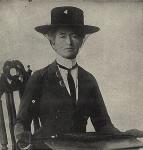Some controversy exists about the date of birth and the background of Daisy Bates. The Australian Dictionary of Biography gives her birth date as 1863 as does biographer Elizabeth Salter in her Daisy Bates, 'the Great White Queen of the Never Never' (1971). Other sources including biographer Ernestine Hill Kabbarli: A Personal Memoir of Daisy Bates, 1973) say 1859, and the SA deaths registrations 1916-1972 give her date of death as 18th April 1951 and her age as 91.
Her origins, as recounted to Ernestine Hill, are that she was the fourth child of James Edward O'Dwyer, Gentleman, and Marguerette (Hunt), and was sent to Australia for her health in 1884 because she was suspected to have TB. Other sources (Heather Radi 200 Australian Women, 1988 and Julia Blackburn Daisy Bates in the Desert, 1994) indicate that she was born into a poor Catholic family and came to Australia as an assisted migrant.
From her time in Australia, though, she is more easily traced. In March 1884 she married Edwin Murrant (generally believed to be 'Breaker' Morant). Soon afterwards he was arrested, and apparently considering the marriage dissolved, she married the cattleman Jack Bates in Nowra, NSW, in February 1885. They had a son, Arnold. In 1894 she left her husband to work in England as a journalist.
In 1899 she returned to Western Australia. She worked on the Trappist Aboriginal Mission at Beagle Bay near Broome, and in 1904 compiled a dictionary of the Bibbulmun language in the south-west of the state. Between 1912-1945 she lived almost entirely with the Aborigines, collecting and recording material about their customs and legends. She came to live in South Australia in 1914, pitching her tent in the hills west of Fowler's Bay, then at Wirilya, 26 miles from Yalata, and at Yuria Waters, 50 miles north of Fowler's Bay. In 1918, broken in health, she came to Adelaide to recuperate, but after a few months moved out to Ooldea siding, on the Nullarbor Plains.
She was a tiny woman, 5'4" tall, remarkable for her Edwardian dress (including gloves) and her decorum even in desert situations. She wrote voluminously (about 300 articles) about the Aboriginal people for newspapers and journals, and fought for reforms in Aboriginal welfare. She was awarded the CBE in 1934. Her autobiography, My Natives and I was published in serial form in Australian newspapers in 1936, and her most important work, The Passing of the Aborigines, written with the help of Ernestine Hill (qv), was published in 1938. Her Aboriginal collection was donated to the National Library in 1940.
After finally leaving Ooldea she lived in Adelaide for the most part, although she lived for a while in a tent on the banks of the Murray River at Pyap, for a while at Wynbring Siding, east of Ooldea, and for a while at Steaky Bay. She grew increasingly weaker and finally died at Semaphore in 1951. She was buried in the North Road Cemetery. The Aboriginal people called her 'Kabbarli' (wise woman, grandmother) but in some areas her work aroused a great deal of controversy. She has been the subject of several biographies and memoirs, an opera and a dance-drama.

